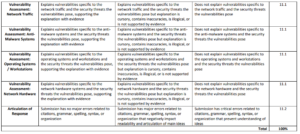Solved: 3-1 Final Project Milestone One
Overview
You will be using the final project lab environment to complete this milestone. Instructions for navigating the environment are located within the lab pane. Once you complete your lab, use your lab notebook, experience in the final project lab environment, and accompanying screen captures of your results in the final project lab. Refer back to your lab tips Visual Aid to review how your work during the module lab activities can help inform your work in your final project lab. This assignment is the first milestone that you will complete for your final project. In this milestone, you will:- Begin drafting parts of your final project document focusing on Sections I and II, the network and vulnerability assessment pieces of your final project.
- This assignment is an important practice opportunity for you to draft and get feedback from your instructor to improve your final draft.
- The rubric for scoring in this assignment has been adjusted to reflect that this is a practice opportunity. You should focus on getting the necessary information into your draft. No draft is perfect. That is why it is a draft.
- Follow the critical elements as a guide. These are the elements you will be graded on in the final project submission.
 Prompt: ABC Manufacturing has hired you as a security consultant to identify security vulnerabilities, provide recommendations, and implement approved changes. Management at ABC has provided you with access to their server networking environment. When the network was set up, the network technician was unfamiliar with the firewall appliance and may have opened up more ports than necessary. Only web services (HTTP and HTTPs) and map service (SMTP) should be allowed from outside of the network.
The client’s internal team has provided a list of tests they want performed based on their own initial analysis:
Prompt: ABC Manufacturing has hired you as a security consultant to identify security vulnerabilities, provide recommendations, and implement approved changes. Management at ABC has provided you with access to their server networking environment. When the network was set up, the network technician was unfamiliar with the firewall appliance and may have opened up more ports than necessary. Only web services (HTTP and HTTPs) and map service (SMTP) should be allowed from outside of the network.
The client’s internal team has provided a list of tests they want performed based on their own initial analysis:
- Scan the firewall for open ports using the tools available to you in the lab environment.
- Determine what the settings on the firewall are for incoming traffic that is allowed. What is it set on? What vulnerabilities does it pose if they are not set?
- Use Microsoft Security Essentials on the client and server Windows machines to determine if vulnerabilities exist.
- Conduct a vulnerability scan on each host desktop using the OpenVAS application on the Kali 2 Linux Box.
- Find vulnerabilities specific to intrusion detection and prevention systems using Wireshark and NetworkMiner.
- Network Assessment – Gathering Evidence of the Vulnerabilities: In this part of your milestone, you will assess the security posture of this network to find what security vulnerabilities currently exist using the appropriate scanning tools and techniques looking at both the pfSense firewall and the Windows Server firewall for the Windows Server host (192.168.1.10). Please see the Final Project navigation pane in the InfoSec environment for a diagram of the systems, users IDs, and passwords you will need to use in that environment. Be sure your responses and supporting evidence address the following questions: a) Firewall: Determine threats to the firewall. For example, are there any ports that are open unnecessarily or unused? Support your response with evidence. b) Virtual Machine (host): Determine threats to the virtual machine (host). For example, are there any ports that are open unnecessarily or unused? Support your response with evidence. c) Determine if there is malicious software protection in place using the tools provided to you. Support your response with evidence. • What kinds of antivirus software, malware protection, or other security software is in place? • What are the risks associated with the gaps in malicious software prevention? • What are the risks associated with leaving the malicious software prevention strategies as they are now? d) Intrusion Detection: What security threats are you finding in the output as you analyze the network traffic? Support your response with evidence from your Wireshark and NetworkMiner tools.
- Vulnerability Assessment – Interpreting Evidence of Vulnerabilities: In this part of your milestone, you will interpret evidence gathered from the network assessment you conducted in Section I to discuss what security vulnerabilities currently exist. In particular, look closely at the scan you performed on the firewall and your Nmap and Zenmap results. Interpret the output from these tools. Be sure your responses and supporting evidence address the following questions: a) What are the vulnerabilities specific to the network traffic? Explain what kind of security threats the vulnerabilities pose. b) What are the vulnerabilities specific to the anti-malware systems (especially centrally managed solutions with aggregated reporting)? Explain what kind of security threats the vulnerabilities pose. For example, what do the Windows security settings tell you? c) What are the vulnerabilities specific to the operating systems and workstations? Explain what kind of security threats the vulnerabilities pose. For example, what did you find when you used the OpenVAS tool? d) What are the vulnerabilities specific to the network hardware (firewall)? Explain what kind of security threats the vulnerabilities pose.



